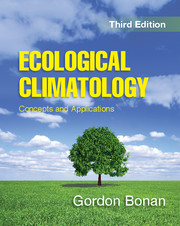Book contents
- Frontmatter
- Dedication
- Contents
- Preface
- 1 Ecosystems and Climate
- Part I The Earth System
- Part II Global Physical Climatology
- Part III Hydrometeorology
- Part IV Biometeorology
- 15 Leaf Temperature and Energy Fluxes
- 16 Leaf Photosynthesis and Stomatal Conductance
- 17 Plant Canopies
- Part V Terrestrial Plant Ecology
- Part VI Terrestrial Forcings and Feedbacks
- Appendix
- Index
- Plate section
- References
17 - Plant Canopies
from Part IV - Biometeorology
Published online by Cambridge University Press: 05 November 2015
- Frontmatter
- Dedication
- Contents
- Preface
- 1 Ecosystems and Climate
- Part I The Earth System
- Part II Global Physical Climatology
- Part III Hydrometeorology
- Part IV Biometeorology
- 15 Leaf Temperature and Energy Fluxes
- 16 Leaf Photosynthesis and Stomatal Conductance
- 17 Plant Canopies
- Part V Terrestrial Plant Ecology
- Part VI Terrestrial Forcings and Feedbacks
- Appendix
- Index
- Plate section
- References
Summary
Chapter Summary
The principles that determine the temperature, energy balance, and photosynthetic rate of a leaf also determine those of plant canopies when integrated over all leaves in the canopy. These processes are related to the amount of leaf area, quantified by leaf area index. The vertical profile of leaf area in the canopy affects the distribution of radiation in the canopy and the absorption of radiation by leaves. With low leaf area index, plants absorb little solar radiation, and the overall surface albedo is largely that of soil. The absorption of radiation increases with greater leaf area index, and surface albedo responds more to the optical properties of foliage rather than soil. The integration of leaf processes over the light profile is central to the scaling of processes from a leaf to the canopy. The carbon uptake by a canopy is the integration of the photosynthetic rates of individual leaves, accounting for variations in light, microclimate, and foliage nitrogen with depth in the canopy. Similarly, canopy conductance is an aggregate measure of the conductance of individual leaves. The profile of leaf area in the canopy also affects turbulence within the canopy. The influence of vegetation on surface fluxes can be modeled by treating the soil–canopy system as an effective bulk surface, or a big leaf. The Penman–Monteith equation applied to canopies is an example of a big-leaf model. Fluxes of CO2 and evapotranspiration measured over forests illustrate the environmental controls of canopy fluxes and the partitioning of fluxes between the canopy and forest floor.
Leaf Area Index
Leaf area index measures the amount of foliage in a plant canopy. Leaf area index is the projected area of leaves per unit area of ground. A square centimeter of ground covered by a leaf with an area of 1 cm2 has a leaf area index of one. The same area covered by two leaves, one atop the other and each with an area of 1 cm2, has a leaf area index of two. Projected, or one-sided, leaf area is different from total leaf area. For thin, flat leaves such as broadleaf trees, total leaf area is twice the projected leaf area (both sides of the leaf are included). For needleleaf trees, total leaf area is more than twice the projected leaf area.
- Type
- Chapter
- Information
- Ecological ClimatologyConcepts and Applications, pp. 264 - 288Publisher: Cambridge University PressPrint publication year: 2015



